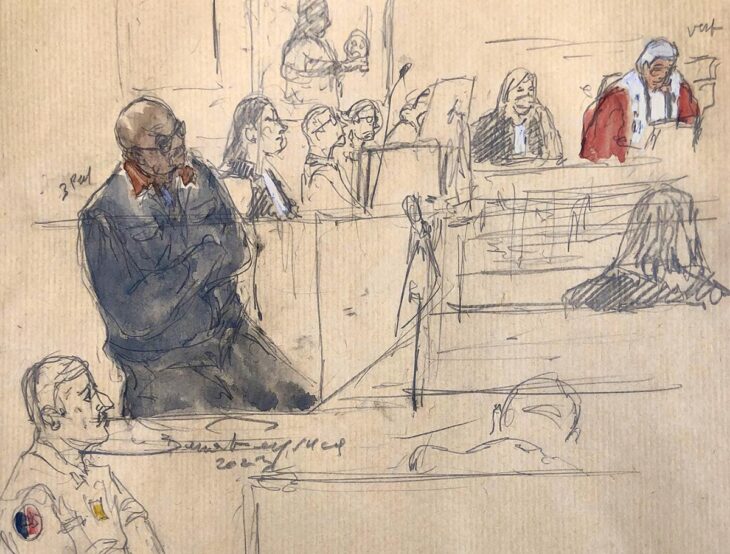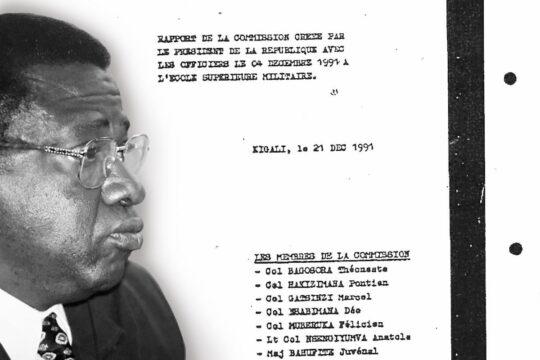Where was Philippe Hategekimana at the end of April 1994, when the first massacres of Tutsis began in the Nyanza region of southern Rwanda? This is the question that haunted the first days of the trial, as colleagues and superiors of the former Rwandan gendarme took the stand or testifies in video-conference. Accused of genocide and crimes against humanity, the 66-year-old man, who became a naturalised French citizen in 2005 under the name Philippe Manier, has been on trial since May 10 before the Paris Assize Court. He is accused of various massacres that took place in the sub-prefecture of Nyanza between 23 April and May 1994. The former Hutu gendarmerie chief warrant officer denies it, assuring that he was not even present in the region for most of the events of which he is accused. In this game of dates that goes back nearly thirty years, it is the accuracy of the memory of the accused and the witnesses that is questioned. While it is established that at some point during the bloody spring of 1994, the accused was transferred from the gendarmerie company in Nyanza to the one in the capital Kigali, the question is to know when.
Hategekimana himself is not clear about the date of his departure from Nyanza. During the investigation, the former gendarme repeatedly contradicted himself. He first stated that he had been transferred on 23 April 1994 to the Kacyiru camp in the capital city, with an effective departure two days later, but then went back on this statement several times, finally concluding that he had left "in the second half of April".
In Kacyiru, he was said to have spent some time under the orders of Major Kanimba, himself supervised by Major Nsapfakumunsi, before being seconded to the security of Colonel Laurent Rutayisire, the director of external security who had just been dismissed and threatened. During the investigation, however, the accused again went back on his previous statements, saying in turn that he had spent a week at the Kacyiru camp before his secondment or, on the contrary, that he had been sent directly to Colonel Rutayisire.
In any event, he would have not participated on 23 April 1994 in the arrest and murder of Narcisse Nyagasaza, bourgmestre of the commune of Ntyazo and a group of Tutsis, because he was then at the Nyanza camp, "preparing his departure". Nor would he have participated on the same day in the massacre on the Nyabubare hill where some 300 Tutsis were killed. When he left, "in [his] mind [he] was already in Kacyiru", he said during the trial. As for the large massacre on Nyamure hill on 27 April, he could not have been there, as he was already in the capital. Nor could he have been present at the massacre at Isar Songa, the Rwandan Institute of Agronomic Sciences, on 29 April.
Memory of the facts and personal conflicts
However, when the former Tutsi gendarme Angélique Tesire took the stand on 17 May, she recognised Philippe Hategekimana as the man who brought the mayor of Ntyazo to the Nyanza camp on 23 April. "I can say many things about him, but I prefer to say the things I witnessed first hand," said the former secretary of Captain Birikunzira, commander of the territorial company of Nyanza. "As for the acts committed outside the camp, I only heard about them because I was not there. But what happened inside the camp, I saw it. One day in April 1994, she recalls seeing Hategekimana returning to the camp in a white van with Narcisse Nyagasaza on board. "I was outside, I saw them and I couldn't stand it" because the mayor, a Tutsi, was "not treated like when he had responsibilities". In my head," she says, "I told myself they were going to kill him”. Brought to the camp to be presented to Captain Birikunzira, the bourgmestre was then allegedly taken to his death by Hategekimana and other gendarmes. But the witness cannot say who, precisely, executed him.
Several days later, during the Isar Songa massacre, she claims to have seen the accused loading a 60mm mortar into a vehicle, telling others to "wait for me, I'm going to stop these bandits". According to the investigation a mortar was indeed used at the Isar, where thousands of people were killed on 29 April 1994. But Tesire was not there and does not remember the exact date. She only remembers that it was the day of the massacre because "on the way back, in the evening, the killers were bragging about it".
In the box, Hategekimana shakes his head and smiles discreetly. This woman is testifying against him out of resentment, he had said during the investigation. In 1993, he allegedly sent her to the hospital to undergo a clinical examination to determine whether or not she had aborted. A procedure designed "to humiliate me because I was a Tutsi", Tesire asserts, when, according to Hategekimana, it was a routine examination.
Anti-Tutsi remarks
When questioned the same day, former gendarme Didace Kayigemera, a Tutsi, also claimed to have seen the former chief warrant officer take the mayor of Ntyazo and load a 60mm mortar into a vehicle on the day of the Isar Songa massacre. He also said that he heard him refer to the Tutsis as "cockroaches". While another witness, a former Tutsi nurse at the gendarmerie camp, reportedly heard him refer to "those Tutsi dogs".
None of these three witnesses directly witnessed the killings allegedly committed by their former superior. "When Philippe Hategekimana went out of the camp, he went out to kill," said Kayigemera. In court, the former gendarme formally recognised the accused, but the latter said he did not remember him.
According to Kayigemera and Tesire, it was in May and not in April that Hategekimana left for the capital. May or April? As the hearings progressed, the date of Hategekimana's arrival in Kigali remained unclear. Major Callixte Kanimba, who was stationed at the Kacyiru camp in 1994, confirmed that he had seen the accused there that spring, when he was interviewed by videoconference from the Rwandan capital on 22 May. It was under his orders that Hategekimana said he had been detached for a time. But Kanimba did not confirm this. The witness was talkative and was not stingy with his estimates. He figured Hategekimana's arrival in Kacyiru was on 19 April, even though he did not see him that day. The major claims that the accused came at the same time as a detachment of gendarmes from the Butare prefecture. The problem is that the accused himself never said that he went to Kacyiru with this detachment on that day. And the former commander of Butare, Cyriaque Habyarabatuma, who was interviewed the previous week, said he had not taken any Nyanza gendarmes with him. He was interviewed by video conference from his Rwandan prison, where he is serving a life sentence in Rwanda for his participation in a massacre of Tutsis in April 1994. He was clear on this point, less so on others. To the French investigators, he had claimed to have heard Hategekimana make anti-Tutsi remarks; in court, he finally admitted that these were reported remarks.
"If I had known that he had been involved in massacres, I would never have recruited him”
Jean-Marie-Vianney Nzapfakumunsi, the only former senior officer in the Rwandan army to appear personally in court, cannot say more about Hategekimana's arrival in Kacyiru or the position he held there. A naturalized French citizen under the name of Munsi, the witness clearly described the hierarchy at work in the camp but denied ever having seen Hategekimana there, whereas the latter claims to have crossed paths with him. A former commander in charge of security at Kigali airport, Nzapfakumunsi lived in the Kacyiru camp, where he was also an officer until May 1994. "I was in charge of operations, I only worked with the unit commanders," he said on 22 May. He had known Hategekimana in the 1980s. He also knew his wife. So if he had run into him at the camp, he probably would have remembered, he said.
A few hours earlier, the president of the court, Jean-Marc Lavergne, sighed at Callixte Kanimba: "My problem is that you say that Mr Hategekimana came to Kacyiru with the Butare gendarmes. But the head of the Butare group says that did not happen. Philippe Hategekimana says that when he arrived he presented himself to you. But you tell me that no, that he was not under your orders. Mr Munsi says that he was not under his orders either. So there is a Hategekimana mystery.” “I have nothing to add, but in your hearings, [you should try and] know exactly who transferred him to Kacyiru," the witness ingenuously advised the presiding judge.
That leaves Colonel Laurent Rutayisire, to whose protection the accused claims he was placed shortly after his arrival in Kacyiru. The 72-year-old former officer lives in Belgium and did not attend the hearing. In a letter sent to the court, he mentions health concerns and an important medical appointment. But above all, he would have nothing more to say than what he had already stated during the investigation, he insisted. The Manier family had contacted him in the past to testify on behalf of the accused, he wrote, but when he learned that the events in question had taken place in April 1994, he explained that he was not in a position to do so. According to him, it was in May that Philippe Hategekimana/Manier entered his service. Read out in court on 16 May, his testimony during the investigation referred to the recruitment of the accused, whom he vaguely knew through his wife and whom he had been recommended for protection. At the time, Rutayisire, considered too moderate by the Hutu extremists, knew he was under threat. Removed from office in April 1994, he was working to prepare his family's flight abroad and decided to recruit an escort for his own safety. "I couldn't say anything about [the accused] background until he was assigned to my protection," Rutayisire told the court. "We didn't talk. There was a gap between people of my rank and those of his. [...] If I had known that he had been involved in massacres, I would never have recruited him.” Rutayisire nonetheless confirmed that Hategekimana, under his orders, had participated in the transfer of a Tutsi family friend of the colonel to the Hotel des mille collines, a place considered relatively safe and guarded by UN forces. The accused stated that he was assigned to the colonel's security between 8 and 10 May. "I said mid-May but it could have been the 10th," Rutayisire replied. "That was more than 25 years ago..."







